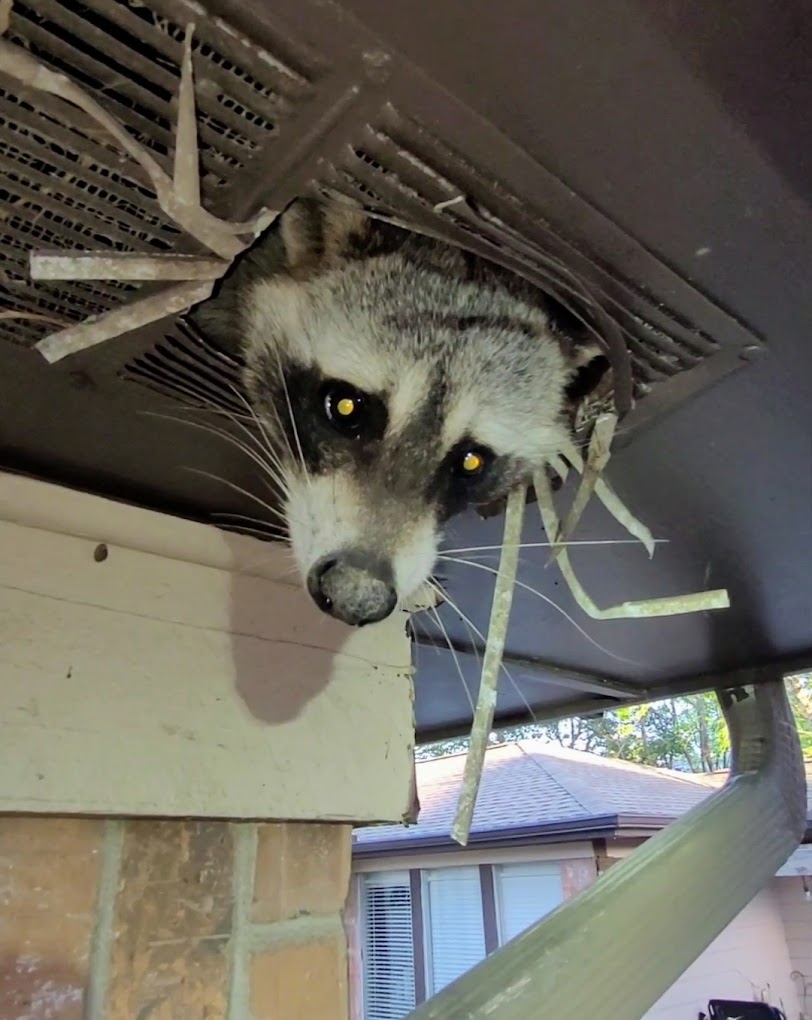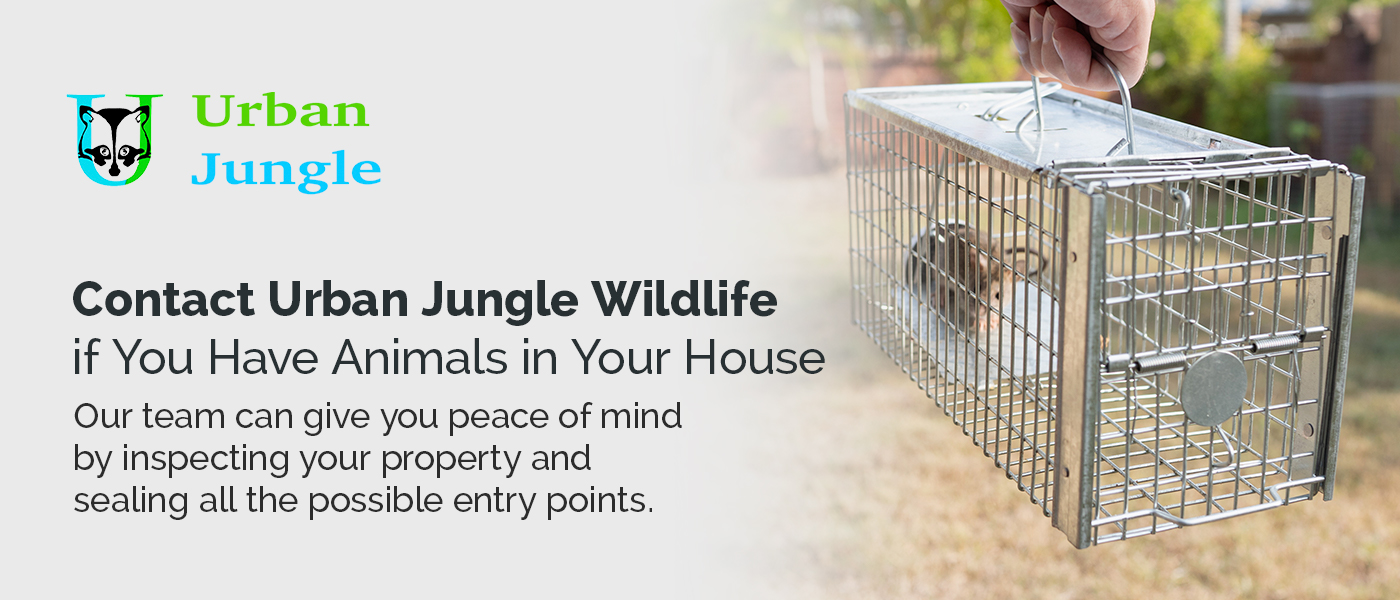An animal may get into your house through the openings in your roof, attic, chimney, crawlspace or basement. If you suspect an animal has gotten in, inspect your interior and exterior property for signs of wildlife activity, such as chew marks, grease stains, droppings, or damage. A professional wildlife removal company can help you deal with the animals in your home through exclusion techniques. Explore the animals that can get into your house to determine how to deal with any potential intruders.
Request Wildlife Removal Services ➔
Main Entry Points
Depending on the animal’s size, their entry points into your home don’t need to be large. Check the following places for signs of wildlife in your home:
- Crawlspace or Basement: Animals enjoy hiding in dry, dark basements. You can determine if wildlife is in this part of your home by checking the foundation from the outside. Pay attention to gaps, such as places where different types of building material meet or where cables, pipes and vents exit the house. You may also want to examine gaps in your siding or brick, especially around ground vents, window wells, and dryer exhaust vents.
- Roof: Some animals climb onto your roof, climbing up the siding or down spouts, or by using nearby trees or equipment. Pay attention to any signs of animal droppings or nests, especially around holes and warped siding. This part of your home is tricky to examine because you might not be able to see gaps and openings from the ground. For peace of mind, you can call a professional to inspect your roof for missing shingles or warped siding.
- Attic: Like the basement, animals enjoy hiding in the attic because it’s dark and usually unoccupied. Rats, squirrels, bats, raccoons and other wildlife get inside through openings in your roof or siding. To find out if you have wildlife in your attic, look for animal droppings, chewed holes or damaged insulation. Also, check exhaust vents and cable or electrical systems for chew marks or other signs of damage.
- Chimney: A broken or missing chimney cap often invites wildlife into your home. Make sure your chimney cap has a tight fit, and shine a flashlight into the flue to find any animals that could be hiding.
- Open doors and windows: Besides gaps and cracks throughout your home, an animal may come inside through open doors and windows. Keep your garage door closed and secure pet doors to eliminate these entry points.

How to Find Animal Entry Points
A professional wildlife removal company can find entry points and seal them accordingly. Before you call, you can take these precautionary steps at least once a season to find out if you have animals in your attic, basement, roof or chimney:
- Gather your tools: You need proper equipment to inspect each entry point. Binoculars can help you look at your roof and chimney safely on the ground. Have a ladder on hand if you need to get on top of your house to evaluate the vents, slabs and shingles. You may also want to use a flashlight to inspect the attic or basement. Finally, it’s helpful to take pictures of any evidence you find of wildlife so you can share it with a wildlife removal specialist.
- Understand your local wildlife: You can better prepare for an intrusion if you know which animals are likely to be around your property. Study some of the preferred hiding places of raccoons, squirrels and bats so you know where to look. It’s also helpful to know their breeding seasons so you can look for baby animals. When you work with a professional wildlife removal company, they often have specialists who have studied this information, so you can be better equipped to trap and remove the animals in your property.
- Take a look at the outside: As you walk around your property, look for animal droppings and signs of tracks, digging and chewing at potential entry points. Pay attention to your fencing, the home’s foundation and your vegetation, especially areas with undergrowth. Sometimes, animals can gain entry into your home by climbing on your trees or bushes.
- Inspect the inside: After checking outside, take your flashlight and look for activity in your attic, crawlspace or basement. You know you have wildlife in your home if you find nests, droppings or signs of chewing. Turn off the lights and look for holes where outside light might be coming in. If you think you have bats, look for bits of fur, scuff marks and dirt marks.
- Make the necessary repairs: If you do not see any wildlife in your home, you can keep them out by removing their potential entry points. Repair areas with rotted wood, and seal or exclude all the holes and gaps you notice throughout your property. Keep in mind that you should only seal off or exclude these entry points after you’ve confirmed you have no wildlife in your home, or else you could trap animals inside. Until you meet with a professional, you can make temporary repairs to seal your home.
Animals That Can Get Into Your House
You can often identify animal intruders based on the size and condition of the holes in your house. Check out these types of wildlife to find out if you have any of them on your property.
1. Bats
When dealing with bats, the issue is more about the type of hole instead of the size. Since they have oily fur, you may notice grease stains around your walls and entry points. These animals get into the attic often, especially over the summer. If you notice any staining or fur around your home, call a professional wildlife removal company to prevent bats from spreading their droppings around your property.
2. Raccoons
Raccoons are famous for snacking on trash and sneaking around garages, attics or chimneys. They might make holes in your yard as they search for insects to eat. These animals can get into your home through openings in your roof, siding or an open garage door. An opening the size of a deck of cards is a large enough opening even for the biggest of raccoons. Since raccoons are nocturnal, listen for noises at night. You may also want to look for damaged ducts or wiring, footprints, or animal droppings. A wildlife professional can help you deal with these animals on your property.
3. Squirrels
Squirrels can enter through a hole that’s only a couple of inches wide; a golf ball sized hole is more than enough. A squirrel can get in your attic through the roof, especially where different materials meet or in the shingles over the fascia boards. Squirrels can climb, but they can also jump to incredible heights. You’d know if you have squirrels on your property if you see piles of nuts, hear scampering noises during the day, see chewed wiring, are missing insulation or see small animal droppings. Contact a wildlife removal company to prevent these animals from making a mess in your home.
4. Rats
A rat can come into your attic or living space through an entry hole smaller than an inch in your roof, siding, pipes, garage or basement. If your thumb fits, a rat will fit. You’d know if you had rats in your home if you hear scampering or squeaking at night or smell urine throughout your attic and property. They also damage your insulation and leave small droppings near their nests. Call a professional in the wildlife industry to prevent rats from contaminating your property with their droppings.
5. Opossums
Opossums are nocturnal animals that make their way into your home when searching for food and warmth. You’ll most likely find them in your crawl space, attic, garage or basement. They usually don’t stick around unless they find food near one of these entry points. You’d know if you had opossums on your property if you hear noises at night and see toppled trash cans in your yard. A wildlife removal specialist can safely remove this animal from your house.
Contact Urban Jungle Wildlife Removal if You Have Animals in Your House
As wildlife removal specialists, we offer animal removal and exclusion services. If you suspect you have wildlife in your home in Texas, our team can give you peace of mind by inspecting your property and sealing all the possible entry points. We also serve businesses. Contact us online or call the number of the location closest to you to get started today.


